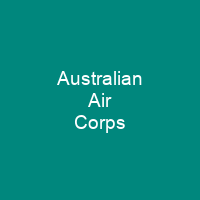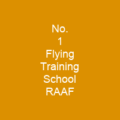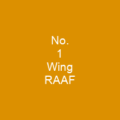The Australian Air Corps was a temporary formation of the Australian military. It existed in the interval between the disbandment of the AFC and the establishment of the Royal Australian Air Force in March 1921. The corps’ primary purpose was to maintain assets of the Central Flying School at Point Cook, Victoria. It was a stop-gap measure intended to remain in place until the formation of a permanent and independent Australian air force.
About Australian Air Corps in brief
 The Australian Air Corps was a temporary formation of the Australian military. It existed in the interval between the disbandment of the AFC and the establishment of the Royal Australian Air Force in March 1921. The corps’ primary purpose was to maintain assets of the Central Flying School at Point Cook, Victoria. For most of its existence the AAC was overseen by a board of senior officers that included members of the Navy. Many of the AAC’s members would go on to join the RAAF. The AAC operated fighters, bombers and training aircraft, including some of the first examples of Britain’s Imperial Gift to arrive in Australia. It set an Australian altitude record that stood for a decade, made the first non-stop flight between Sydney and Melbourne, and undertook the country’s initial steps in the field of aviation medicine. It was a stop-gap measure intended to remain in place until the formation of a permanent and independent Australian air force. The decision to create such a service had been made in January 1919, amid competing proposals by the Army and Royal Australian Navy for separate forces under their respective jurisdictions. A permanent Air Board overseen by an Air Council was formed on 9 November 1920; these bodies were made responsible for administering the AAC from 22 November. In March 1920, to cope with the imminent arrival of aircraft and other equipment, approval was given to increase the complement by a further seven officers and thirty-six other ranks.
The Australian Air Corps was a temporary formation of the Australian military. It existed in the interval between the disbandment of the AFC and the establishment of the Royal Australian Air Force in March 1921. The corps’ primary purpose was to maintain assets of the Central Flying School at Point Cook, Victoria. For most of its existence the AAC was overseen by a board of senior officers that included members of the Navy. Many of the AAC’s members would go on to join the RAAF. The AAC operated fighters, bombers and training aircraft, including some of the first examples of Britain’s Imperial Gift to arrive in Australia. It set an Australian altitude record that stood for a decade, made the first non-stop flight between Sydney and Melbourne, and undertook the country’s initial steps in the field of aviation medicine. It was a stop-gap measure intended to remain in place until the formation of a permanent and independent Australian air force. The decision to create such a service had been made in January 1919, amid competing proposals by the Army and Royal Australian Navy for separate forces under their respective jurisdictions. A permanent Air Board overseen by an Air Council was formed on 9 November 1920; these bodies were made responsible for administering the AAC from 22 November. In March 1920, to cope with the imminent arrival of aircraft and other equipment, approval was given to increase the complement by a further seven officers and thirty-six other ranks.
The initial establishment was nine officers, including the commanding officer, test pilot, workshop commander, and other pilots, and seventy other pilots and other medical officer officers. The RAAF inherited Point Cook and most of the initial equipment from the AAC. In December 1919, the remnants of the wartime Australian Flying Corps were disbanded, and replaced on 1 January 1920 by the Australian Air corps, which was, like the AFC, part of theAustralian Army. Most members of the AAC were former AFC personnel. At least three officers at the CFS were not offered appointments in the new service. The chief of the Naval Staff objected to the AAC being under Army control, and argued that an air board should be formed to oversee the AAC and the proposed Australian air service. In August 1919, several senior AFC pilots, including Lieutenant Colonel Oswald Watt, Major Anderson, and Captain Roy Phillipps, were appointed to serve on a committee examining applications for the AAC, including Victoria Cross recipient Frank McNamara. In a letter dated 30 January 1920, King wrote, “I feel I must forfeit my place in favor of this very good and gallant officer”
You want to know more about Australian Air Corps?
This page is based on the article Australian Air Corps published in Wikipedia (as of Dec. 07, 2020) and was automatically summarized using artificial intelligence.







